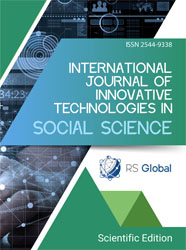ARTIFICIAL INTELLIGENCE AND MARKETING INTERSECTION POST-COVID-19: A CONCEPTUAL FRAMEWORK
Abstract
As a result of mass digitization during the pandemic, businesses were able to automate business processes, giving people and brands a deeper connection. A proactive strategy, however, is the next step for organizations to implement AI during crisis situations by going one step further. In spite of this, most organizations still do not adequately address this growing problem. After Covid outbreaks, consumer behavior is unlikely to return to pre-pandemic levels. Consumers will increasingly buy goods and services online, and more people will work remotely. In the post-Covid-19 world, as economies slowly begin to open up again, artificial intelligence (AI) will be extremely valuable as companies begin to adapt to the new environment. Similar to other global crises, several major trends that were already underway before Covid are likely to accelerate as a result of the pandemic. Companies must continue to invest in artificial intelligence initiatives during the recovery phase. A conceptual framework for marketing and user engagement is presented in this paper that uses artificial intelligence and automation in ways that are user-centric, integrating traditional marketing practices into an overarching framework that can be implemented by structured artificial intelligence. Embedded technologies, artificial intelligence, and automation have had a significant impact on the four Ps of marketing and will continue to do so.
References
Abaffy, L. (2013). “App Locates Metal Studs With iPhone’s Magnetometer.” ENR: Engineering News-Record, 271(1), 25–25.
Abaffy, L. (2011). “iPads and Tablets: Time Saved Vs. Time Spent.” ENR: Engineering News-Record, 267(9), 20– 20.
Baisya, R. K., & Tiwari, S. P. (2008). E-governance Challenges and Strategies for Better-managed Projects. Emerging Technologies in E-Government, 203-208.
Baisya, R. K., & Tiwari, S. P. (2014). E–governance and its impact on enterprise competitiveness: Trends, Status and Challenges
Norton, J. A., & Bass, F. M. (1987). A diffusion theory model of adoption and substitution for successive generations of high-technology products. Management science, 33(9), 1069-1086.
Ojanpera, T., & Prasad, R. (1998). An overview of air interface multiple access for IMT-2000/UMTS. IEEE communications Magazine, 36(9), 82-86.
Raab, R. T., Denning, G. L., & Cruz, R. R. V. (1998). The impact of IRRI's training program: a different perspective. Impact of rice research., 159-191.
Stadelman, S., & Madey, G. (1987). The Impact of R&M 2000 on Business Planning. IEEE transactions on reliability, 36(3), 371-376.
Tiwari, S. P. (2022). Information and communication technology initiatives for knowledge sharing in agriculture. arXiv preprint arXiv:2202.08649.
Tiwari, S. P. (2022). Emerging Technologies: Factors Influencing Knowledge Sharing. World Journal of Educational Research.
Tiwari, S. P. (2022). Organizational Competitiveness and Digital Governance Challenges. Archives of Business Research, 10(3).
Tiwari, S. P. (2022). Knowledge Management Strategies and Emerging Technologies--An Overview Of the Underpinning Concepts. arXiv preprint arXiv:2205.01100.
Tiwari, S. P. (2022). Covid-19: Knowledge Development, Exchange, and Emerging Technologies. International Journal of Social Science Research and Review, 5(5), 310-314.
Tiwari, S. P. (2022). Re-emergence of Asia in the New Industrial Era. Technium Soc. Sci. J., 29, 471.
Tiwari, S. P. (2022). Knowledge Enhancement and Mobile Technology: Improving Effectiveness and Efficiency. arXiv preprint arXiv:2208.04706.
Tiwari, S. P. (2015). Strengthening E-Commerce Product Launches-Improving Efficiencies from Development to Production. Project And Technology Management Foundation (A Non-Profit Organization) Member of Asia Pacific Federation of Project Management, 1(2), 4-6.
Tiwari, S. P. (2015). Business: Innovation & Survival, by a Googler
Shapiro, S. C. (1992). Encyclopedia of artificial intelligence second edition. New Jersey: A Wiley Interscience Publication.
Steels, L. (1993). The artificial life roots of artificial intelligence. Artificial life, 1(1_2), 75-110.
Suchman, L. A., & Trigg, R. H. (1993). Artificial intelligence as craftwork.
Winston, P. H. (1992). Artificial intelligence. Addison-Wesley Longman Publishing Co., Inc.
Views:
343
Downloads:
393
Copyright (c) 2022 Shoucheng Zhang

This work is licensed under a Creative Commons Attribution 4.0 International License.
All articles are published in open-access and licensed under a Creative Commons Attribution 4.0 International License (CC BY 4.0). Hence, authors retain copyright to the content of the articles.
CC BY 4.0 License allows content to be copied, adapted, displayed, distributed, re-published or otherwise re-used for any purpose including for adaptation and commercial use provided the content is attributed.











